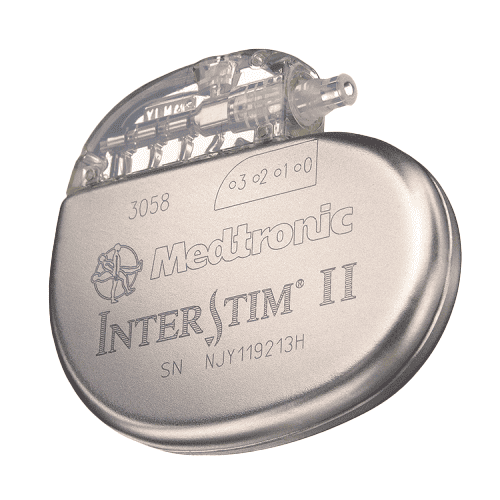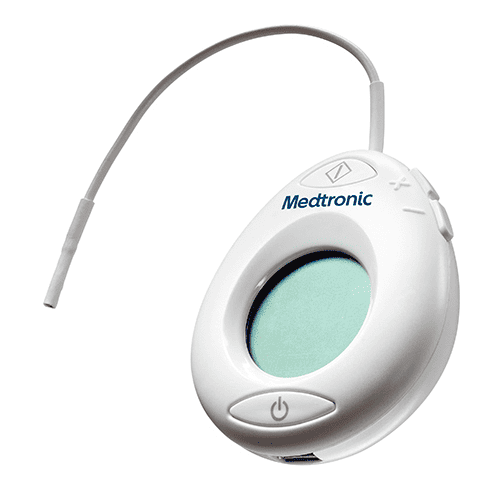Medtronic Bladder Control Care Pathway

Medtronic Bladder Control Care Pathway
There are many ways to manage bladder control problems. Remember, if conservative treatments don’t deliver the results you need, you have more options.
Step 1: Diagnosis
"What is happening to me?"
If you’re experiencing symptoms of bladder control problems, it’s time to meet with a bladder control specialist. Your doctor may ask you to fill out a symptom diary to get a better idea of your daily experience and confirm your diagnosis.
Symptoms of Overactive Bladder (OAB) include:
Urge incontinence
- Going before you reach the bathroom
- Experiencing frequent leaks
- Using pads or protective garments
Urgency-frequency
- Frequent, uncontrollable urge to go
- Going more than 8 times a day
- Feeling like your bladder is never empty
Symptoms of Urinary Retention include:
- Can’t tell if your bladder is full
- Holding increasingly large amounts of urine
- Weak or dribbling stream
- Needing to use a catheter

Step 2: Lifestyle Changes
"What should I try first?"
Conservative treatments can help some people, but may not work very well (or at all) for others. All of these are relatively simple behavioral changes that you may already be doing.
- Diet and exercise: Changes may include decreasing your caffeine intake and getting more exercise.
- Bladder retraining: Also called biofeedback, this involves delaying going to the bathroom and sticking to a strict schedule.
- Pelvic floor strengthening: This can be accomplished through Kegel exercises, which involve repeatedly contracting and relaxing the muscles of the pelvic floor.

Step 3: Oral Medications
"Are there medications for OAB?"
When lifestyle changes fail to deliver the results you want, oral medications are the next step. These medications can help control symptoms, but may cause other issues.
You have to remember to take these medications every day. Some side effects can be unpleasant, such as dry mouth, blurry vision, constipation, and hypertension. Other side effects are more serious. In fact, limited study data suggests that one class of drugs for OAB (anticholinergics) may increase risk of dementia in elderly people.1
Even more important, these medications don’t always work. In one survey, 72 percent of people said they stopped taking their medication after just six months.2

Step 4: Advanced Therapies
If both lifestyle changes and medications fail to improve bladder control, there are non-medication treatment options to consider.
Medtronic Bladder Control Therapy Delivered By The Interstim™ System
If you’re ready to try an advanced approach, Medtronic bladder control therapy delivered by the InterStim™ system can help. It targets the nerves that control your bladder to help it function normally again.
- Try it during an evaluation
- Proven long-term relief 3, 4
- Resources and support available
Implanting an InterStim™ system has risks similar to any surgical procedure, including swelling, bruising, bleeding, and infection. Talk with your doctor about ways to minimize these risks. Complications can occur with the evaluation, including movement of the wire, technical problems with the device, and some temporary pain. Your doctor or nurse will provide you with the information regarding how to operate the test device, and inform you of other precautions related to the evaluation and activity restrictions.
Medtronic Bladder Control Therapy Delivered By The Nuro™ System
Medtronic bladder control therapy delivered by the NURO™ system targets the tibial nerve to help you regain control of your bladder. By restoring bladder function, this therapy puts you on a path to fewer trips to the bathroom, fewer pads per day, and more of the activities you enjoy.6, 7
- Convenience of in-office treatment
- Proven to restore bladder function
- Resources and support available
Most common side effects are temporary and include mild pain or skin inflammation at or near the stimulation site. The NURO™ system does not treat symptoms of urinary retention.
Injected Medications
Injected medications can temporarily treat OAB but may raise other concerns.
- Must be repeated every 3-6 months
- Potentially requires self-catheterization8
- Increases the risk of bladder infection due to self-catheterization8


Ready To Schedule An Appointment?
Contact us today to schedule your appointment with our team of professionals.
Phone: (615) 284-4664